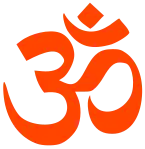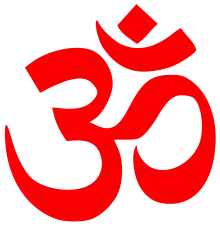Tvastar
In the historical Vedic religion, Tvaṣṭṛ (Sanskrit: त्वष्टृ) is the artisan god or fashioner. The Purusha Sukta refers to the Purusha as Tvastr, who is the visible form of creativity emerged from the navel of the invisible Vishvakarma.[1] In the Yajurveda, Purusha Sukta and the tenth mandala of the Rigveda, his character and attributes are merged with the concept of Hiranyagarbha/Prajapati or Brahma. The term, also transliterated as ...Tvaṣṭr, nominative Tvaṣṭā, is the heavenly builder, the maker of divine implements, especially Indra's Vajra and the guardian of Soma. Tvaṣṭṛ is mentioned 65 times in the Ṛgveda[2] and is the former of the bodies of men and animals,' and invoked when desiring offspring, called garbha-pati or the lord of the womb.[2] Tvastr is also referred to as the father of Indra and Agni.[3]
| Tvastar | |
|---|---|
The Heavenly Builder The Maker of Divine Implements Lord of the Womb | |
| Affiliation | Deva |
| Texts | Purusha Sukta |
| Personal information | |
| Parents | Shukra and Urjjasvati or Prahbasa and Yogasiddha or Kasyapa and Aditi |
| Consort | Virochanā |
| Children | Indra, Agni, Saranyu, and Trisiras |
| Equivalents | |
| Greek equivalent | Hephaistos |
| Norse equivalent | Völund |
| Slavic equivalent | Svarog |
| Part of a series on |
| Hinduism |
|---|
 |
|
As per the Ṛgveda, Tvaṣṭr, also known as Rathakāra, belongs to the clan of the Bhṛgus. Similarly, as mentioned in the epic Mahābhārata, Tvaṣṭṛ or the Rathakāra is Śukrāchārya's son, Śukrāchārya (the mentor of the asuras) is Bhṛigu's grandson and Vāruṇibhṛigu's son. Tvaṣṭṛ is sometimes associated or identified with similar deities, such as Savitṛ, Prajāpatī, Viśvakarman and Puṣan. He fathered Vritra, as well as the twins Trisiras and Saranyu, with his wife, Virocanā.[4] Virocanā is a daitya famously known as Prahlada's daughter and Virocana's sister.[5] He is the father of Saranyu, who twice bears twins to Vivasvat (RV 8.26.21), including Yama and Yami, also identified as the first humans.[6] He is also the father of Viśvarūpa or Triśiras, who was killed by Indra. In retaliation, Tvaṣṭṛ created Vritra, a fearsome dragon who defeated Indra, but was eventually slain by the latter by using the bones of the rishi Dadhichi to create the Vajra weapon.
Tvaṣṭṛ is a solar deity in the Mahābhārata and the Harivaṃśa. He is mentioned as the son of Kāśyapa and Aditi and is said to have made the three worlds with pieces of the Surya.
See also
Citations
- अ॒द्भ्यः सम्भू॑तः पृथि॒व्यै रसा॓च्च । वि॒श्वक॑र्मणः॒ सम॑वर्त॒ताधि॑ । तस्य॒ त्वष्टा॑ वि॒दध॑द्रू॒पमे॑ति । तत्पुरु॑षस्य॒ विश्व॒माजा॑न॒मग्रे॓ ॥ Rigveda 10-82
- Macdonell, Arthur Anthony (1995). "Abstract Gods". Vedic mythology. Vedas. Motilal Banarsidass Publ. pp. 116–118. ISBN 9788120811133.
- Stephanie Jamison (2015). The Rigveda –– Earliest Religious Poetry of India. Oxford University Press. p. 51. ISBN 978-0190633394.
- Brahmanda Purana, III.59
- Brahmanda Purana, III.59
- Brahmanda Purana, III.59
